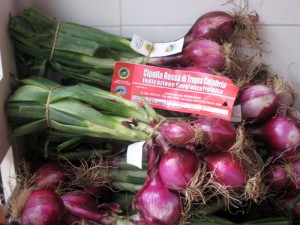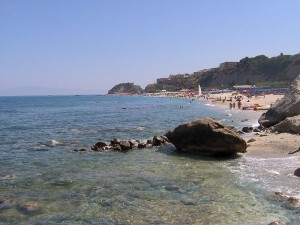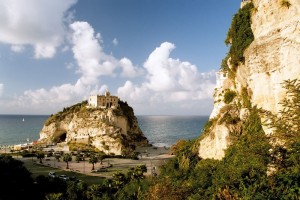One day a friend of mine from Calabria was telling me how beautiful the beaches are in that region and she mentioned Tropea. I told her it’s strange how she brought up Tropea because it’s the second that day I’ve heard about Tropea and I had never heard about it previously. Just that morning in the fruit and vegetable shop near my house, the shopkeeper was trying to convince one of his customers to buy the Tropea red onions which he said are superior than just regular onions. So that got me interested about Tropea and these red onions from Tropea. My friend insisted that I absolutely have to try them as they are really exceptional.
So, exactly where’s Tropea?
Tropea is a gem that sparkles along Calabria’s rugged and gorgeous Tyrrhenian coastline. Praised for its beauty since ancient times, the town is said to have been founded by Greek hero Hercules and is known for its myths and mythic beauty. While ruins of Greek and Roman settlements have been found, today’s visitors are attracted by Tropea’s cliff side setting, marvelously clear seas and white sandy beaches. With some of the best beaches in the south of Italy, it’s no wonder that Tropea is one of the top destinations in Calabria for both tourists and Italians.
Off the beaten path
Italy’s region of Calabria stretches down into the toe of the boot and is off the beaten path for many visitors in Italy. This is part of what makes the seaside town of Tropea such a unique place to visit. The city is much more than its dreamy beaches, however, and the best way to see the town is to take a leisurely stroll along its narrow and charming streets. No matter where you start, the blue of the sea dominates the street and city views beckoning you down to the sea.
Historic Town Center
Walking through the historic center of town, you’ll find streets lined with the once luxurious palazzos that belonged to the nobility. Although medieval in origin, many of the palazzos show the flourishes of their Baroque redecorations. The carved granite doorways of the palazzos, often topped with a grotesque mask to scare off the evil eye, are one of the architectural highlights of Tropea.
From Piazza Ercole in the town’s center, Via Roma leads to the Largo Duomo and Tropea’s fine Cathedral. Inside, the Cathedral is awe-inspiring in its simplicity. It contains several important works of art, including a 14th-century wooden crucifix and a fine statue of The Madonna and Child by the Florentine sculptor Giovanni Angelo Montorsoli. Above the high altar is the 13th century icon of the town’s patron the Madonna of Romania, which was supposedly painted by St. Luke.
After exploring the town’s historic center and small streets, follow the Corso Vittorio Emanuele to the affaccio, a scenic viewpoint overlooking the cliffs and sea. Nearby, on the top of a steep rock is the symbol of Tropea, the small church of Santa Maria dell’Isola. Once a Benedictine sanctuary located on an island, the church can now be reached by a staircase carved out of the rocks in the 8th century.
Climb the small path lined with fishermen’s caves leading up to the church of Santa Maria dell’Isola. An atmosphere of peace and calm fills the gardens full of fig trees behind the church. This is the spot to end a perfect day in Tropea, taking in the outstanding views of the coastline while watching the sun set over the Aeolian Islands and the blue Mediterranean Sea.
 BrowsingRome Blogging about my experiences and sharing my thoughts about Rome, Italy and beyond
BrowsingRome Blogging about my experiences and sharing my thoughts about Rome, Italy and beyond


